Variant Covers: Comics’ Greatest Heroes or Most Fearsome Foes?
We take a deep look at the merits and position of variant covers in today's industry
The world of comics is filled with polarizing subjects. Just go on Twitter for a day and drink it in. Everything from sales minutiae to the cliché conversations about “which character is stronger” can lead to lengthy debates. It’s hard to keep up.
But one of the greatest, most divisive subjects is the value of variant covers. Depending on who you ask and what day it is, they could be godsends or bringers of the apocalypse. “They’re predatory!” “They’re a boon to the industry!” “Maybe they’re both!” It’s a subject no one can decide on because it’s dependent on perspective.
But in theory, variant covers are neat things. Providing readers a choice of the art on the comic they’re buying is an attractive idea. For retailers, it could be beneficial to have rare artifacts to sell to collectors. Many publishers love them as they create more product with limited overhead while giving retailers a reason to goose orders.
As special items, the appeal of variant covers is obvious. But what happens when they aren’t so special anymore? When they become the new normal? That’s the quandary we’re in these days, because variants? They’re as ubiquitous in comics as spandex.
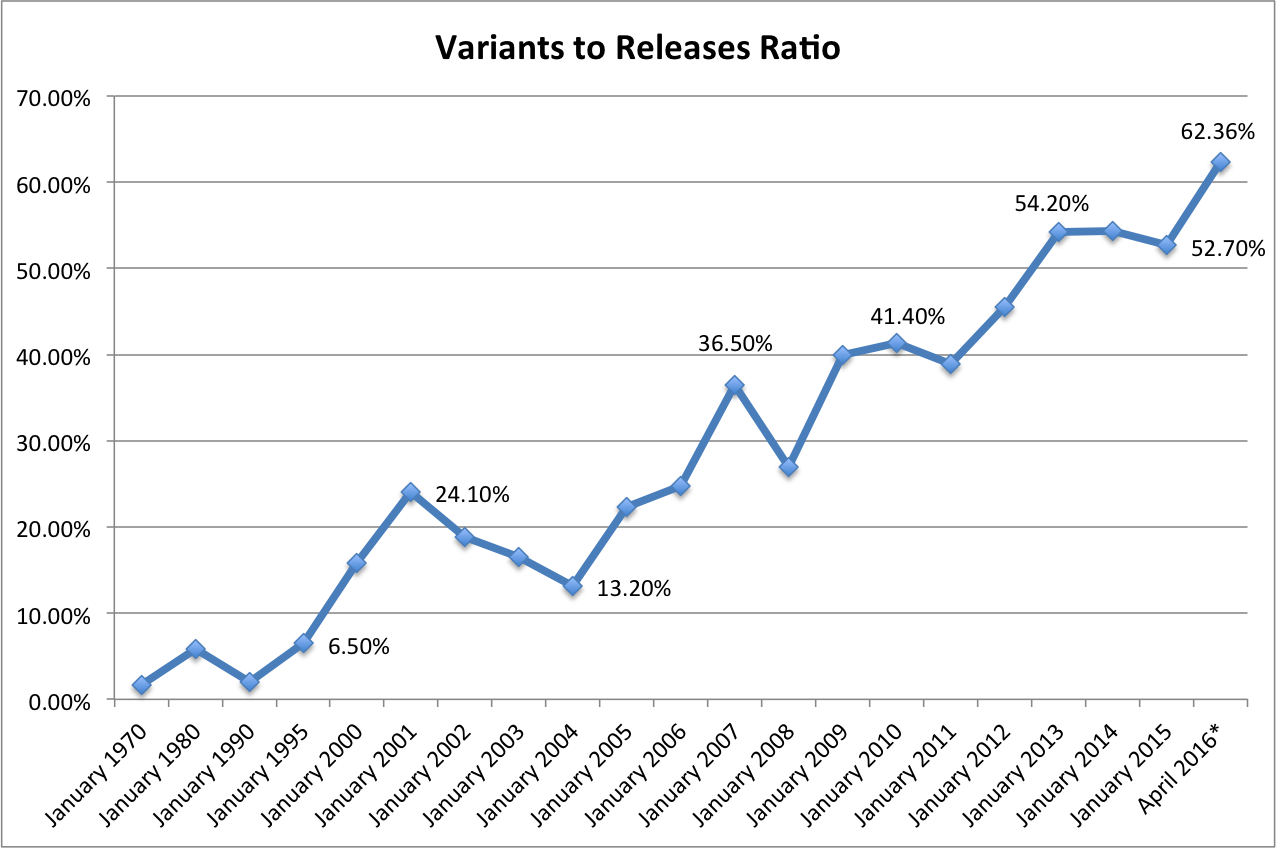
What the chart above displays is the ratio of total variants – meaning the total variant covers, not just comics with a variant – to total releases in comics (including collections) mapped out from 1970 to 2016. Before moving on, a quick shout out to Peter Bickford and ComicBase for sharing the data. While April 2016 was calculated by myself through the most recent Previews, the rest of the chart was all him.
It shows the stunning abundance of variants. They’ve become so commonplace there are over three variants for every five comics released this April. These once novelty items have grown almost every year since 2004, and here’s the wild thing: if you just look at comics – not including collections – there are actually 12 more variants than titles in April. It’s hardly a stretch to say the recent growth in industry sales numbers is connected to the increased presence of variants.
So the question circles back to the beginning: is that such a bad thing? Again, it depends on perspective, but today, we will try and suss out an answer. We’ll do it by getting perspectives from the three main players involved: readers, retailers and publishers. Once all angles are considered, perhaps we can come up with a proper answer.
But let’s provide framework for the discussion to start.
What’s included in the term “variant cover?”
Variants are so convoluted even deciding what to include when discussing them is a mess. I bet if you asked a comic fan who has been around since the 1990’s, they might say the old hologram covers on the X-Men crossover Fatal Attractions were variants. But they weren’t! They were a gimmick, not a variant. So when we’re talking about variants, what are we talking about? For an answer, here’s Bruno Batista of Big Bang Comics.
A/B/etc. covers
Variant covers that are regular price and freely orderable.Example: The variant covers most Image books do where you have a cover by a different artist that are still normal cover price.
A/B covers, themed
Variant covers that are regular price and freely orderable but follow a particular theme.Example: The Wicked + The Divine variant covers comprised of headshots of the characters, or DC Comics’ themed variant months (i.e. Neal Adams Month).
Subscriber covers
Variant covers that are regular price and freely orderable, but aimed at standing order/subscription customers.Example: Any IDW book’s SUB covers. These are A/B cover variants marketed to retailers as ideal for pull list customers.
A/B covers, unlockable
Variant covers that are normally regular price but require you to order a certain number of the A cover before you can order an equivalent number of the B cover.Example: Oni Press’ upcoming Heartthrob #1. If you want 10 copies of the Jamie McKelvie variant, you need to order 10 copies of the regular cover.
Incentive variants, by quantity
Variant covers that are not regular price. They require you to order a certain number of copies to unlock a set quantity of the variant.Example: Dark Knight III Jim Lee variants available to order at the ratio of 1 in 500, meaning you need to order 500 copies of the regular comic to get one variant.
Incentive variants, by percentage
Variant covers that may or may not be regular price. They require you to order a certain number of copies to beat the threshold of a previous order which will then unlock a freely orderable variant.Example: A lot of Marvel’s variants are like this. To unlock the Skottie Young variant for Gnarly Inhumans #7 you have to order 125% of what you ordered of Fresh X-Men #32, meaning if you ordered 100 copies of Fresh X-Men #32 you’ll need to order 125 copies of Gnarly Inhumans #7 to then be able to order whatever copies you want of the Gnarly Inhumans #7 Skottie Young Variant.
Retailer Variants
Variant covers that may or may not be regular price, ordered through individual deals between Retailers or Groups and Publishers. These are available only through certain retailers.Example: The Valkyrie Variant for Pretty Deadly #6 or the Ghost Variants done by a group of retailers.
One not mentioned were the blank covers for artists (or anyone, really) to sketch on. They’re commonplace for publishers these days and require no levels to be met for orders, except in some instances (one shop mentioned Marvel sometimes makes them incentive based).
The Reader Perspective
You would think the customers for variants are the same as those for comics themselves. Why not? They’re all comics, right? At times, that’s true. Some who buy variants are your average comic fans who get one because it looks nice or, sometimes, because of an honest mistake.
“Often it’s by accident,” shared Nicolas Papaconstantinou when asked if he ever buys variants. “When I say by accident, I mean that now I quite often don’t know which is the actual cover, because if there are two covers and both of them are equally related to what’s inside the comic, I won’t always know which is the main cover and I’ll pick the prettiest.”
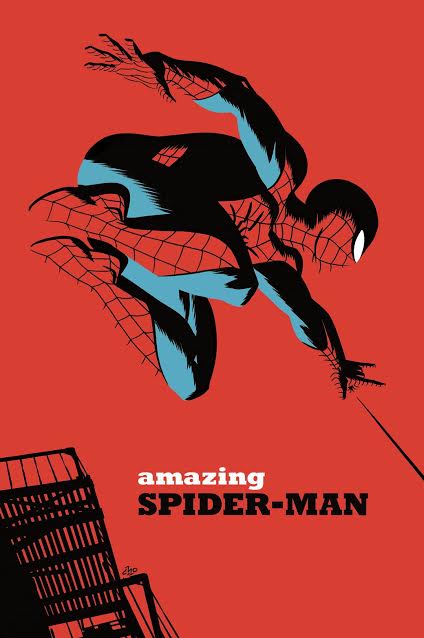
He isn’t the only one who happens upon a variant without thinking about it.
“I can’t really even remember the last time I intentionally bought a variant. I have in the past, but only vary rarely,” shared Beth Walthaus. “I mix between picking my pull list up from a brick and mortar shop and getting them online, so occasionally I get a variant ‘by accident’ so to speak.”
While she admits to buying higher priced variants in the past – “if it’s focused on a character I love or if it has been made by an artist I admire” – Walthaus seemed to mostly end up with one by happenstance. She, Papaconstantinou and several others cited that as the most common reason for ending up with a variant. It’s a camp I belong to.
I’ve never paid higher than cover price for a variant, and if I’ve come home with one, it’s often because I was picking favorites out of stack of competitors. I appreciate the options cover price variants provide, as titles like Injection and Archie are ones I often come home with a variant on. But if they didn’t exist, I’d just get the book with whatever cover was available.
The only variant covers I’ve ever desired are the Michael Cho variants dropping at Marvel this month. But I’m not willing to pay $12 for each of them, and not for titles I’m otherwise passing on. Most agreed with that sentiment.
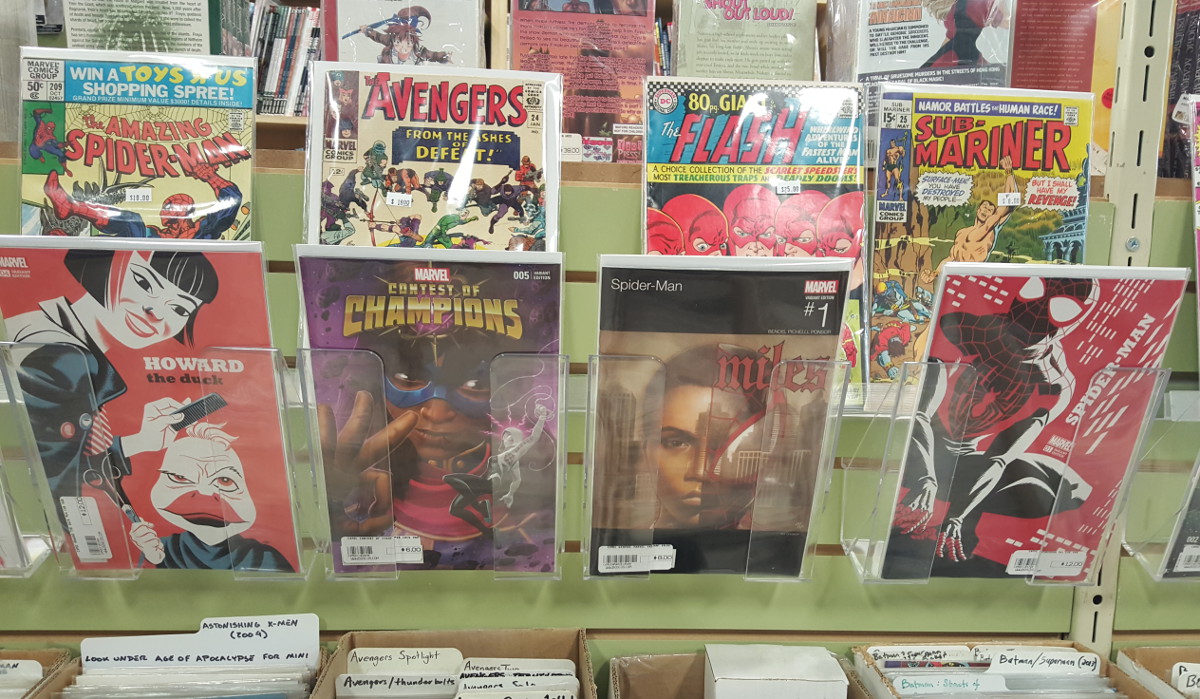
One other reason for readers to buy variants is the simplest of all: because they’re given no other choice.
“I think I have actually bought more out of necessity rather than choice, simply because my shop was out of the original cover,” shared Seth McKay.
Several shared that reasoning, which makes sense. The majority of readers who contributed answers are just that: “readers.” Many felt uncomfortable with comics as collectibles, saying variations of this line by Batista – “I don’t see the point, personally, of buying something for 10 times the price just because the art on the outside is different when it’s the art on the inside that counts.” Most were in the business of reading the comics, and variant covers were inconsequential to them.
That said, some fit the bill. There were several people who buy variants for a multitude of reasons. Sometimes it’s just out of love for the book.
“On average, I’d say I buy variant covers three to four times per month,” said Erica Pascalides. “Truthfully, I don’t need them, but if I like the creative team, I like to buy more than one copy of the issue. I buy variants for Tokyo Ghost and Huck consistently because I love everything about the titles.”
She wasn’t alone in that regard, as a few others cited this as an important reason. However, the titles mentioned were all creator-owned. At least the readers I spoke with invest more in that variety of books.
Julian Antonio made an interesting note about variants unrelated to the purchase of them: how they introduce him to new artists.
“I do like the fact that, with comics, you can see different artists’ take on a character or a story all the time. That’s one of the things that drew me to comics and I’m glad variant covers exist, just for the pleasure to look at them and say, ‘whoa, that Marguerite Sauvage cover for Ninjak #1 is so gorgeous…who is she? What did she do before that? I NEED TO KNOW EVERYTHING ABOUT HER,’” he said. “Covers are one of the first things that I look for when solicitations drop: sometimes to marvel at that awesome Joëlle Jones variant cover, sometimes to discover new artists…and sometimes I also get new wallpapers for my smartphone!”
There’s value in that for readers, creators and publishers, even if it doesn’t generate revenue.
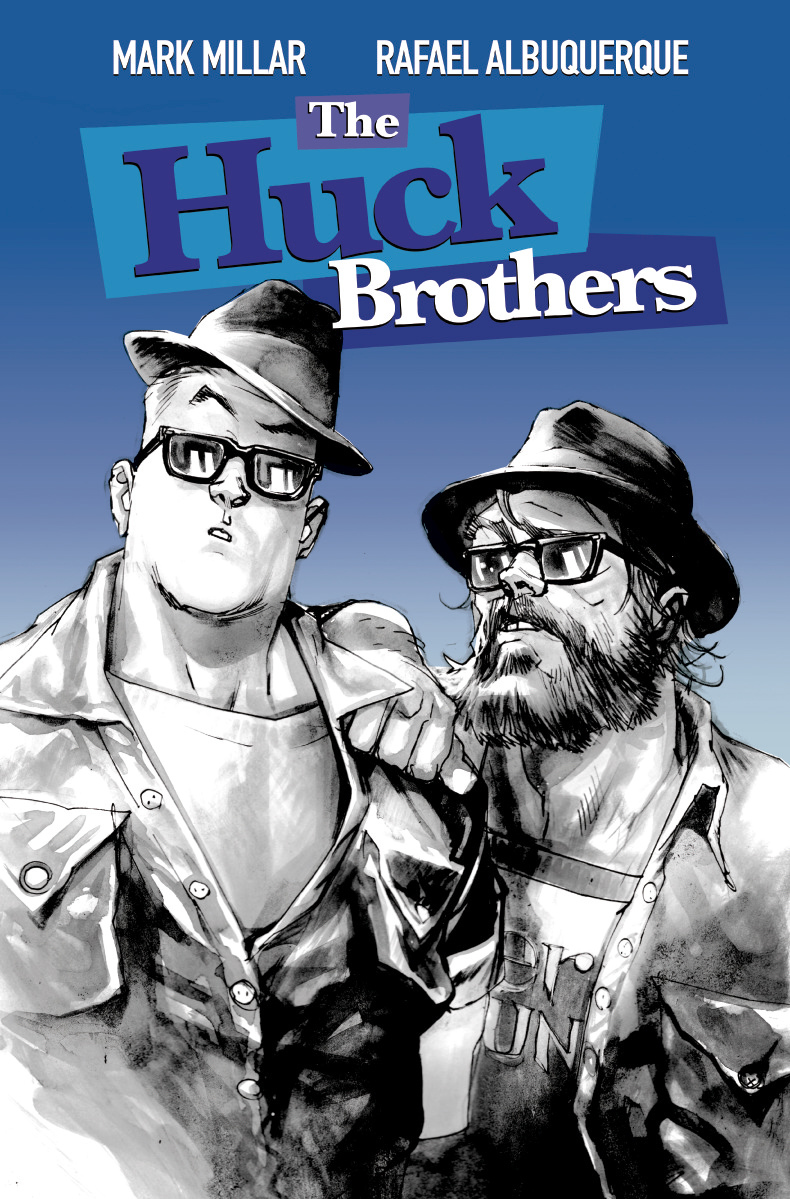
James Kaplan mentioned nostalgia was a big factor for him when he ended up going home with the action figure variants for Star Wars and Secret Wars, as those covers reminded him of his childhood. Pascalides agreed with this sentiment, sharing nostalgia as a big part of the appeal of the Huck variants.
The most common reason for picking up a variant was the artist, though. And one fascinating note about those who pick up variants was how many were primarily digital readers. Their favorite artists convince them to buy in print as well.
“Since I buy floppies for the artist, I will purchase variant covers if they are by one of the artists that I collect,” shared Michael Perlman. “I am a bit of a completist when it comes to these artists so I will get the variant no matter how rare or high priced (to a point). For example, I own a copy of every published book/cover by Christian Ward and Chip Zdarsky except his 1:4,999 Star Wars one.”
Despite great enthusiasm from some, overall, the tenor of the 30 or so respondents was one of ambivalence. Mostly, variants didn’t move the needle or convince them to buy a comic, but they were purchased from time to time out of need. Several were happy with cover price variants, and a few went above and beyond for pieces by artists they enjoyed. However, a few shared frustration with the process. Steve Robinson was one of them. While he used to buy variants and even discovered new titles because of them, these days, he’s sworn off them for the most part.
“I tried to do the right thing by my comic store, creative teams and publishers by attempting to pre-order like they always beg you to do. I’d see a variant cover I’d love and attempt to order it, only to be told ‘we have no idea how much this is going to cost,’” he said. “I can’t play that game. I have to know how much I’m spending and be able to budget. That said. If I walk into a comic shop and they have a variant I love? I have in the past spent up to £45 on a variant issue. I would do (it) again for an artist I love.”
“I just won’t ever pre-order. Ever.”
This doesn’t just affect the reader; it impacts their shop, the creative teams and the publisher. That can be a major problem.
The Retailer Perspective
No one I spoke to had more diverse opinions than comic shops. Retailers have many ideas on the subject, and depending on the shop, variant type, title and publisher, their thoughts could splinter. After all, variants have many wrinkles. Because of that, this is the most complicated section.
It is worth noting, though, that even the most anti-variant shops find value in the basic options. They can provide variety to readers without additional cost or greater orders. Shops I spoke to think they’re great. It’s the incentive variants that frustrate the most. We will focus on those here.
Let’s start with the shops that are fond of variants. For some, these items can make up a big part of their business. While it depends on the variant, there were shops who have seen substantial value come from them.
Dennis Barger of Wonderworld Comics was the strongest supporter, and he shared it was for an array of reasons.
“The incentive variants really set the stores that participates in them apart,” he said. “(At) my store we charge more for them so it increases sales on certain book(s), brings in collectors from other stores that don’t order them and has that ‘collect them all’ chase factor.”
He cited a recent example to prove his point. When BOOM! launched their new Mighty Morphin Power Rangers series with a zero issue in January, they had a line of popular incentive variants available. While Barger ordered big on those, other regional shops didn’t. He saw customers traveling 45+ minutes to get them from him. According to Barger, they get “a customer excited for a new comic and keeps them coming back.”
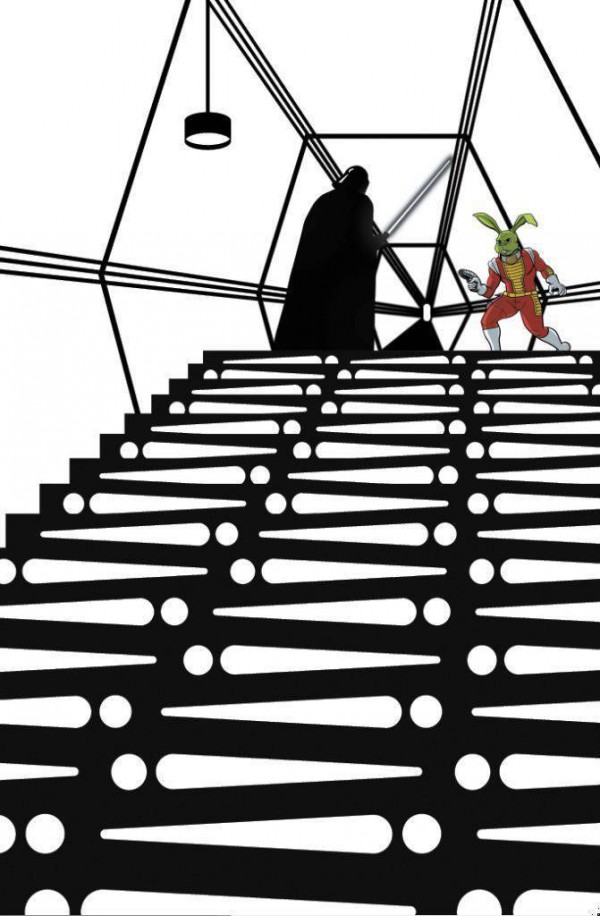
Barger also orders some of the more extreme variants with positive results. He ordered a 1:4,999 (meaning to get one copy of the variant, you have to order 4,999 copies of the regular cover) Chip Zdarsky variant for Vader Down #1 that Marvel rolled out. He ended up selling his copy for almost $4,000, paying for half of his print run with just that.
Even better, the regular covers featured information about his store on them. The plan is to give them away for purchases of $60 or more at cons this year. Barger calls them “the best business card you can have at a show,” and has found value even in the regular editions of the book.
Still, Barger calls variants a “fun but dangerous game.” If you handle it wrong, you could take a huge loss. But he finds them to be a differentiator for his shop, and only orders big on comics he knows will sell for a long time. He’d never “just dump them,” and it’s a side of the business he thinks many retailers dislike because “it doesn’t instantly gratify you with cash or turn over all the time.”
“I have noticed a lot of retailers get very impatient,” he added.
While not as universal of a supporter as Barger, Ben Lichtenstein of Zapp Comics has found value in a specific segment of variants: retailer exclusives. These and other, more rare offerings other shops might not carry have driven strong results for his store.
“The benefit of variants is that, in some cases, we are able to offer exclusive or difficult to acquire variants that our customers may not find at other outlets,” he said. “When we produce our exclusive Zapp variants, that’s obviously a way to gain exposure and drive traffic to our stores and website.”
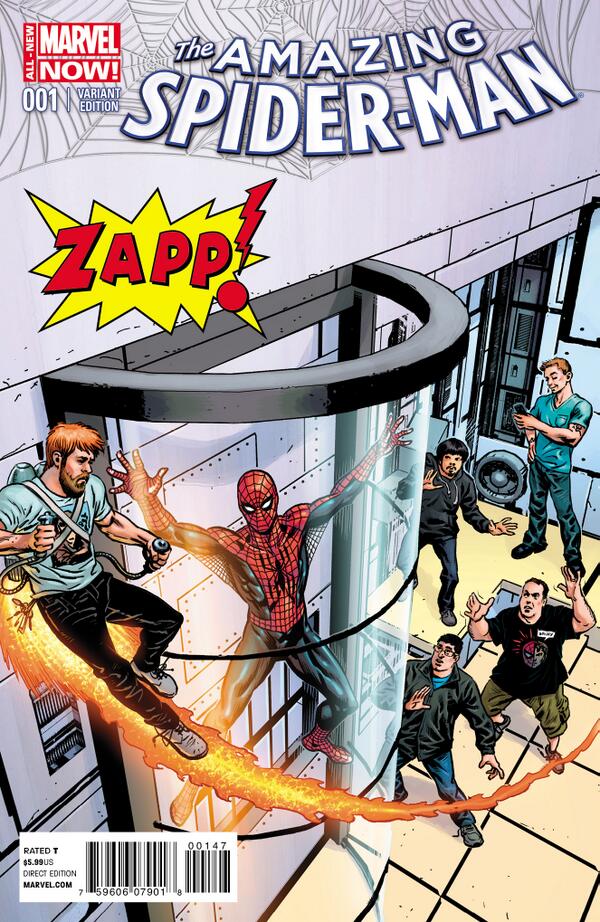
Zapp plays it “safe” by focusing on the most popular titles – like Star Wars and Batman, for example – and Lichtenstein mentioned one particular release as doing well: an Amazing Spider-Man #1 variant featuring shop employees on the cover.
Retailer exclusive variants have proven powerful elsewhere, most notably the Ghost Variant program created by a group of shops. That doubled as a successful business venture and a wonderful artistic endeavor.
It’s not all roses from Lichtenstein, of course. He shared “variants are not a big part of (Zapp’s) business,” and that shops can “easily get buried in large quantities of unsold books” if they chase the wrong one. But he has found value in certain situations, and a big reason is the “long-term view” they plan these buys with. Being strategic with which variant you buy into is important.
Some shops were on the fence about them, although they shared sentiments that were universal. One of the most common refrains was incentive variants aren’t bad if they’re of a reasonable level. Megan Nielsen of Bosco’s Comics said, “if we’re eligible for a variant, we’ll order it.” That’s the case for most. There’s no reason to pass up something you’re eligible for. That said, Nielsen shared even with those, her shop has toned down orders because of a decline in variant sales.
Hank Kwon of Bulletproof Comics & Games was one of a bevy of shops who qualified for the aforementioned Dark Knight III 1:5,000 variant DC Comics created. This variant was signed and sketched on by Jim Lee. Each was a one-of-a-kind artifact for the shop. While variants are featured on his shop’s site and he continues to order them, he realizes they can be trying. It’s easy to see why when he explains the story of the DKIII variant.
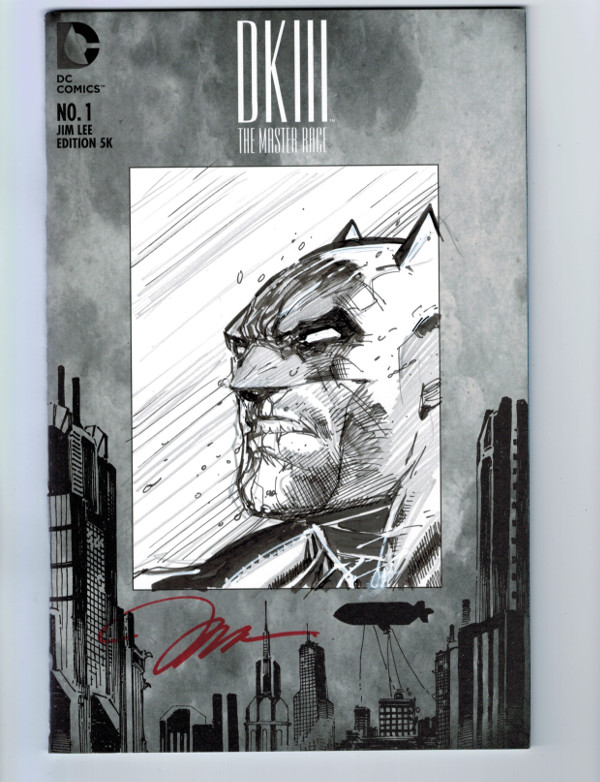
“For me to get the 1:5,000 variant, I had to order $22,000 worth of books to receive them. It was a big risk but a calculated one,” he said. “I receive an exclusive store variant cover and hope it will cover my initial buy in. Also, luck has a lot to do with these variant covers because if you receive a cover that is not well received by the public, then you can lose a good chunk of the investment. For me, I have to sell about half my inventory to break even. I have not yet done so.”
“But you have to keep it in stride because it will eventually sell.”
For those betting big on variants, patience is a virtue. But it can wear on even the most easy-going of shop owners. One that weighed on Kwon was the biggest point of consternation of all: Marvel’s Hip-Hop variants. Kwon ordered those to match customer demand…or so he thought.
“Marvel makes us order more than our usual number – usually twice the regular number – to qualify to order these books,” he said. “Without having to see what the variants look like, it’s a big gamble. We sell the Hip-Hop covers at cover price. I have a lot of the regular covers left over so it really was not worth it for my shop in this case.”
These covers drew the ire of many retailers I spoke to before, like Orbital Comics’ Chris Thompson. He found the hype led to his shop ordering big and the gap to release caused them to sell little.
“Had Marvel released their Hip-Hop variants three or four months ago, when they were pushing them through major press, then we would’ve sold a boatload,” he said. “But now, months later, the fervor has gone and those people who excitedly asked about them have now forgotten they exist – which is bad news for us and, in the long-term, bad news for Marvel.”
Because of that, his shop will be more cautious with Marvel variants. It didn’t help that the ordering process for those covers was a headache. Several mentioned the mental gymnastics they have to go through as one of the biggest negatives for variants.
“Currently my biggest gripe with variants is how long they take to order,” Nielsen said. “Frequently a cover requires that I go back and look at my order numbers for past covers so I can see if I’m even able to order the new variant cover. So the process is already delayed by having to order six other covers, but then I’m slowed down even further by having to go back and figure everything out.”
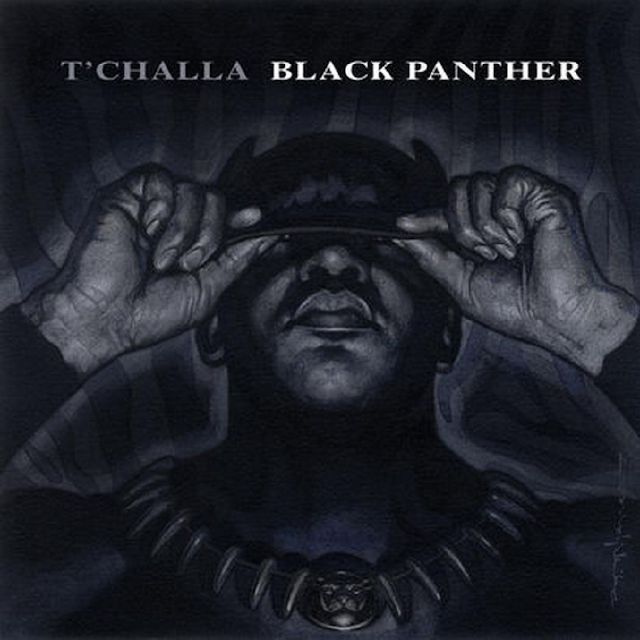
If that sounds weird, it’s because it is. One upcoming release exemplifies this well. It’s Black Panther #1 at Marvel. There are ten variants available, all of which sound intriguing. To qualify for them, you’d have to calculate your numbers based off five different incentive levels while also ordering 25% more copies for this book than you did with Doctor Strange #2.
So if you ordered 100 copies of Doctor Strange #2, you would have to order 125 of Black Panther #1 for three incentives, which would get you anywhere between one and 12 copies of others. From that you’d have to guesstimate how much you’d want of each based off consumer demand. Got that?
That’s just one comic of 500 in April.
You can guess why retailers say to never get in their line of work. It’s an exhausting process, and one that has made the experience of ordering comics a nightmare. And as some noted, customers don’t care if you can’t meet these demands – they just want the covers, and if you don’t have them, they’ll go elsewhere. It’s a predicament that can make shops seem like the bad guy.
Some retailers outright dislike them. Patrick Brower of Challengers Comics + Conversation said, “they are ridiculous and hurt the industry.” Others I spoke to echoed that sentiment.
It doesn’t help that they’ve become so ubiquitous. Barger was the most ardent supporter I spoke to, and even he said if “you do too much, you numb the market to how fresh the variety is.” Again, variants are special until they become the norm, like now. Several shops reported less interest in these items as they become more abundant.
That said, there is something to be said for responsibility within the stores. Scott Tomlin of Comics Dungeon – who believes the high incentive variants are dangerous for the industry – shared, “retailers hold the keys here, smart ordering is the way to go. Variants are gravy, but sometimes you have to pass on the gravy.” He’s right. If these items didn’t move, publishers wouldn’t make them. Enough shops are ordering them that they’ve proven valuable to publishers, and as businesses, of course they’re going to keep going with what adds to their bottom line. Shops have to be careful in their variant tactics, especially now.
The Publisher Perspective
We know the basic reason publishers create these items: money. They bring in revenue and they get people talking, and both are currency in the world of comics. But each publisher approaches them differently. Before getting into their thoughts on variants, let’s examine numbers from comics coming in April. We know a lot of variants are in the mix there, but who is releasing the most?
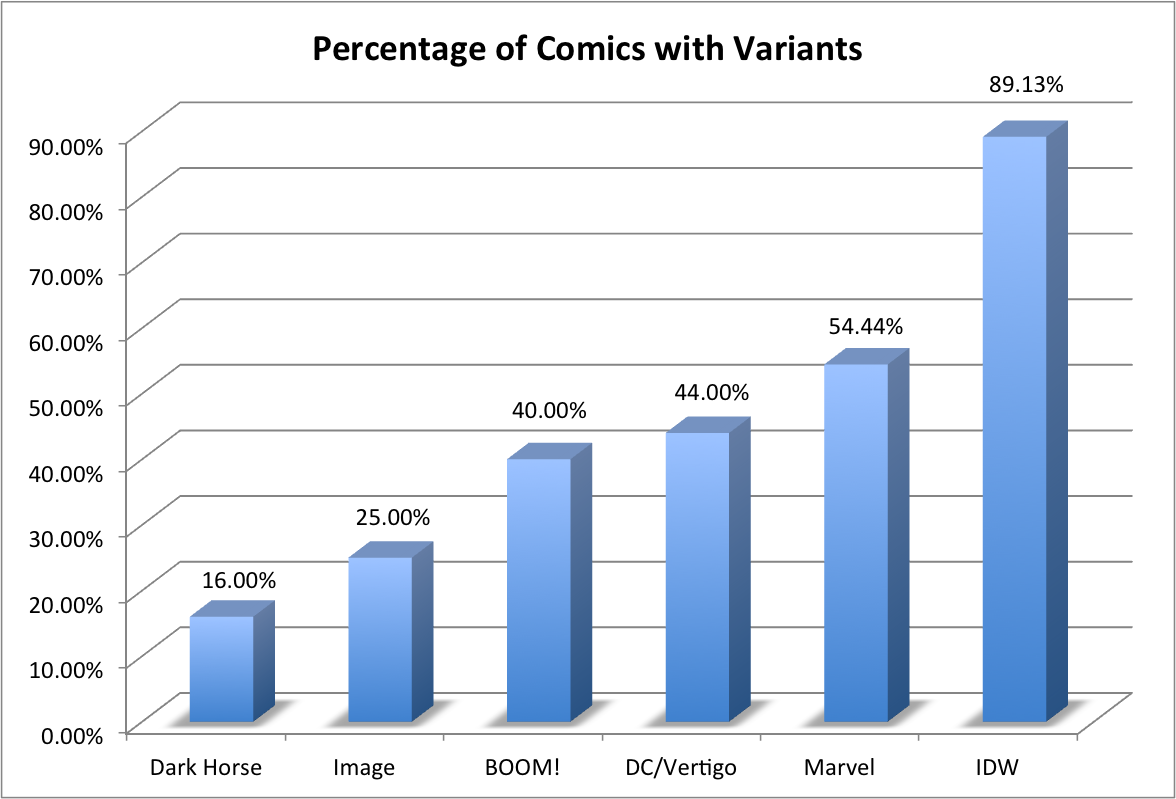
This first chart examines a simple ratio: the total amount of comics – not including collections – that are being published with a variant to go along with it. On the high end is IDW. From my count, over 89% of their releases in April come with a variant. Marvel and DC are within range of 50%, and Dark Horse and Image bring up the rear. Now let’s look at another breakdown. This one is releases – including collections – divided by the total variants at each publisher.
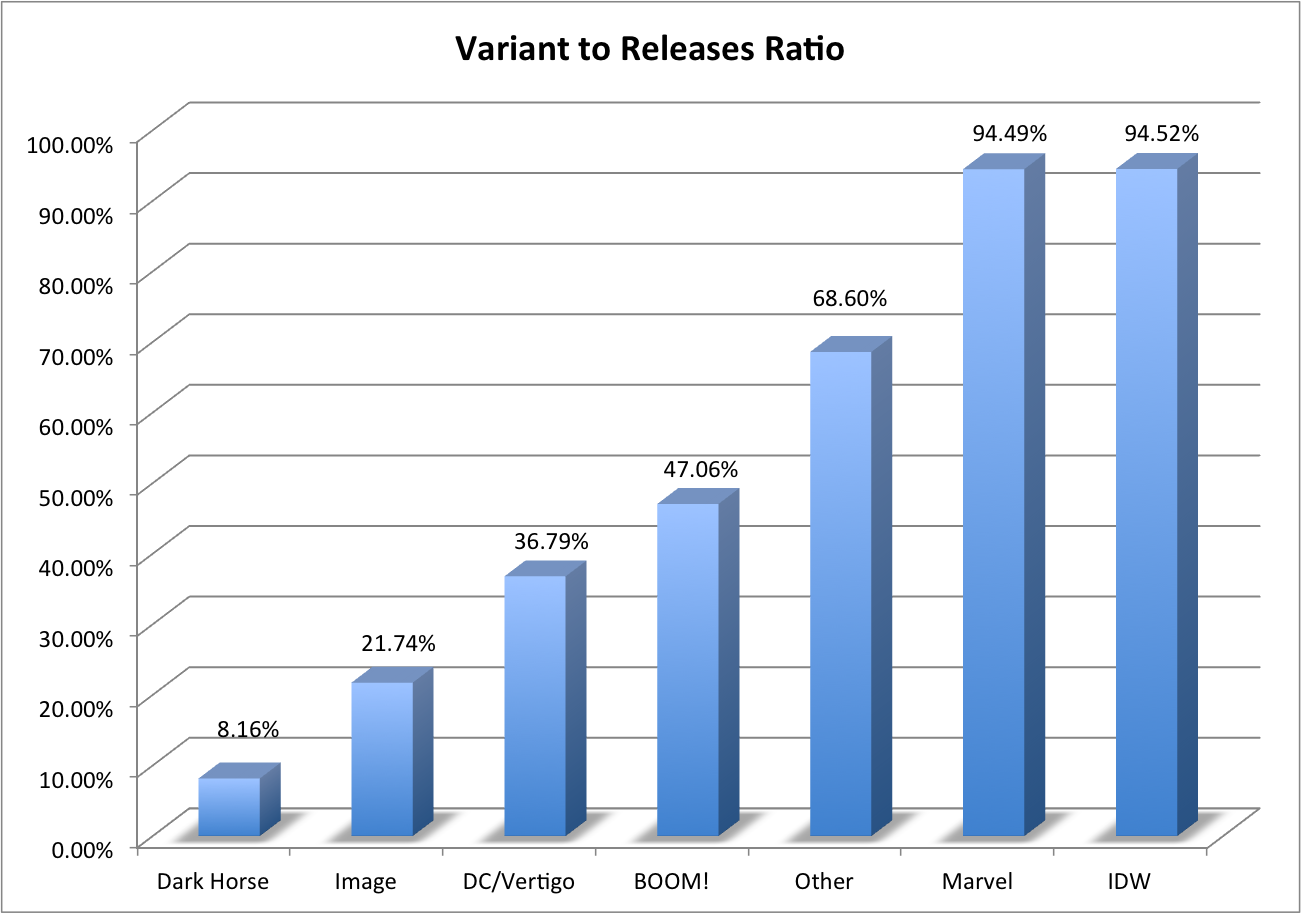
IDW is still at the top, but in this iteration (which counts each variant in total rather than each comic that has a variant), Marvel is close to the top. A lot of books at Marvel have a laundry list of variants, with the aforementioned Black Panther #1 and Poe Dameron #1 having ten each to lead the way. Both publishers have almost one variant per release. That’s well above average.
Both pale in comparison to other houses, though. Boundless Comics is releasing two comics in April with an unconscionable 37 variants – almost 19 per release! While they were the clear leader, Avatar wasn’t far behind, as their release list was outnumbered by variants 4.5 to one.
One number I found interesting was how DC/Vertigo decreased chart to chart. While they employed a fair amount of incentive variants, few of their titles had more than one variant. That wasn’t what I expected.
When you look at the charts above, each publisher clearly has a different perspective on their value. While I could guess at the reasons behind their usage, it only felt fair to give them the chance to share why they use variants as much as they do. Not every publisher participated, of course. DC Comics never responded, BOOM! declined comment, and both IDW and Valiant didn’t get answers back in time for release. But others did, and they provide valuable insight. Let’s start with the house who releases the least: Dark Horse.
“We’re not in the business of using variants as a means (to) spike market share or forcing completists to have to purchase twenty different covers of the same issue. We’re rather selective when choosing to do variants on our books and base our decisions on titles we know the retailers can sell and fans will want. We also structure our variant incentives in a realistic way so that any retailer can qualify for variant cover ordering,” shared Matt Parkinson, Dark Horse’s Vice President of Marketing.
The second lowest user – and one who primarily ran A/B variants requiring no additional orders – was Image. I spoke to both their head and one of the top creators. Let’s start with Eric Stephenson, their publisher. I asked him for Image’s stance on variants, and it was a subject he had strong feelings on.
“Retailer variants are pointless. They’re short-term cash grabs that do nothing for a book’s health. When Corey Murphy started here, we were doing a lot of them — I think there was one title last year that has something like a dozen covers for its first issue — and there wasn’t any real analysis going into what happened after that,” Stephenson said. “But Corey took a hard look and what was happening (was) there were stores signing up for these exclusive covers and then literally never ordering another issue of the book. Or if they did order the book again, the orders for issues one, two, whatever — they are next to nothing. No support whatsoever. And that’s not a fruitful partnership.”
Stephenson also mentioned options like Loot Crate as short-term boosts that provide no real benefit in the long-term. It drives revenue up front but they found them to be a bubble, which they try to avoid. In his mind, everyone else should too. “Right now, everything we do as an industry should be geared toward making sure we’re still around in the future.”
“As far as Image goes, that is our policy. There are books that do standard variants that everybody can order, but we do not do retailer exclusives on single issues at this point.”
While they no longer produce incentive variants on comics, they are creating them for trades. Stephenson views them as items with a longer shelf life that also can be acquired without enormous order requirements. He said that project is in its infancy and that they will keep an eye on how it works for all involved.
“As with everything we do, the main criteria is whether or not it’s promoting sustainable growth,” Stephenson said.
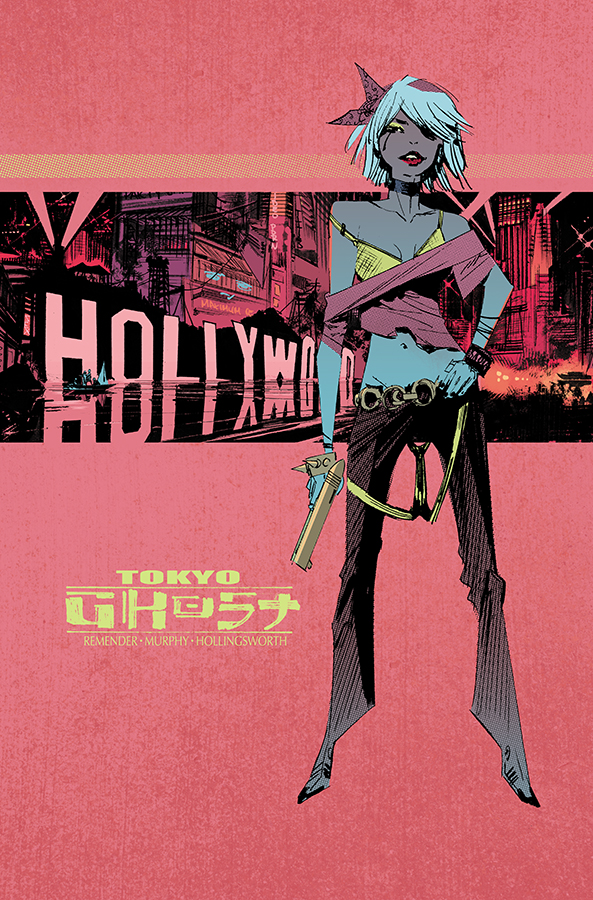
As a creator-owned house, Image’s writers and artists play a factor in whether the more innocuous A/B variants are included in the mix. I spoke with Sean Murphy on why his book with Rick Remender, Tokyo Ghost, isn’t hiring outside artists for variants.
“I’ve outsourced variant covers in the past, but the added cost to the artists was usually greater than the net,” he said. “It also artificially inflated the numbers, which made it hard to know how many actual readers we had (some readers obviously double dipped) and how many books to print for the next issue. Another reason I stopped is because it put (an) unfair burden on the shops. It’s a very ‘90s age’ thing to do, so I wanted to be careful.”
While they still produce B variants for collectors, he draws them, so paying another artist no longer eats into his bottom line. And even though his stance on variants has moved from including them on single issues, he called the exclusive variants on trades – particularly when they are CGC graded – an “exciting trend.”
Oni Press isn’t a huge user of variants. However, they do leverage them occasionally, typically with only one extra cover. Their Editor-in-Chief, James Lucas Jones, shared his thoughts on them.
“Variant covers are a complicated issue that I have mixed feelings about. As an independent, creator-focused publisher, they have the potential to aid in our ongoing battle for exposure for unproven titles and creators,” he said. “A cover from an established talent works a lot like a great pull quote from a creator with a following. For comics based on an existing property, they provide an opportunity to work with other fans of that source material who may not be able to take on full art chores for a comic or a short.”
“That said, it’s a cheap parlor trick that hopefully gooses the sales on a first issue, broadens our readership base, and makes it easier to sustain quality work. Note that I’m saying ‘hopefully.’ The idea of selling ‘collectibles’ rather than ‘content’ is not really the Oni Press way and we’ve made a conscious effort to steer away from ‘1-in-some-absurd-number’ variants and instead do our alternate covers as open order, limited only by the order number on the standard retail cover.”
He added he enjoys retailer exclusives, citing how they can be beneficial for all the players, but that variants are a subject they’re “constantly reevaluating” their approach on to “maximize both our immediate and future audience growth.”
The last publisher who provided feedback for the piece was Marvel. It’s a touchy subject they’re at the center of. They know this. Still, David Gabriel – their SVP of Sales and Marketing – provided insight into how and why they use variants. He was the perfect person to do so, as he was the one who brought them back to Marvel.
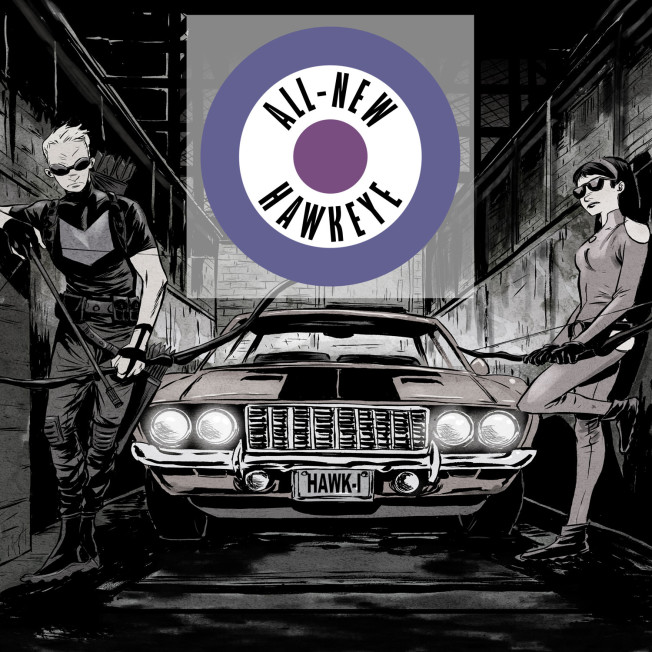
“I can say that I personally heralded the return of variant covers way back in 2005 with New Avengers #1,” Gabriel said. “And 11 years ago, we said the same things we say today. We make variants first and foremost to serve as marketing and promotion for comics. We will make and sell variants as long as they are selling. And lastly we have always affirmed that any retailer or customer who doesn’t want a variant, shouldn’t buy one.”
Gabriel has found they’re helpful in promoting their comics, getting new customers in retail stores (he cited the Spider-Man cover Barack Obama appeared on) and acting as “financial boons to those retailers who use them wisely.”
“The fact that we’re talking about them as a ‘thing’ shows that they are important to the industry and as long as we keep a careful watch on them, they’ll continue to be so.”
According to Gabriel, Marvel’s aware of the outcry against variants, but he noted this isn’t something shops are unified against in their perspective.
“We are definitely aware that a few vocal retailers say this, but this is not something that the majority of retailers call out,” he said. “The repeated and increased sales over the past few years just do not support this as an overwhelming concern.”
Gabriel shared Marvel has years of sales data showing what works and what doesn’t, and incentive variants are something they’ve found to produce results. That said, he wanted to add their “goal is always and has always been to make our retailers money and keep them in business.”
“We never want to have a retailer buy copies of a book just so they can sit on shelves or in warehouses. That helps no one. We’re in this business to tell the greatest stories we can and we want those stories in the hands of readers. Seeing all this any other way just doesn’t make sense. This last year has been the most successful year in recent memory for the entire comics industry, (and) one of the factors is absolutely the strategic use of variant covers.”
He realizes the process can be difficult, however. Knowing many retailers struggled with the experience of ordering the Hip-Hop covers, I asked Gabriel how that will impact what they do going forward. Thankfully, he shared they are aware of the difficulties.
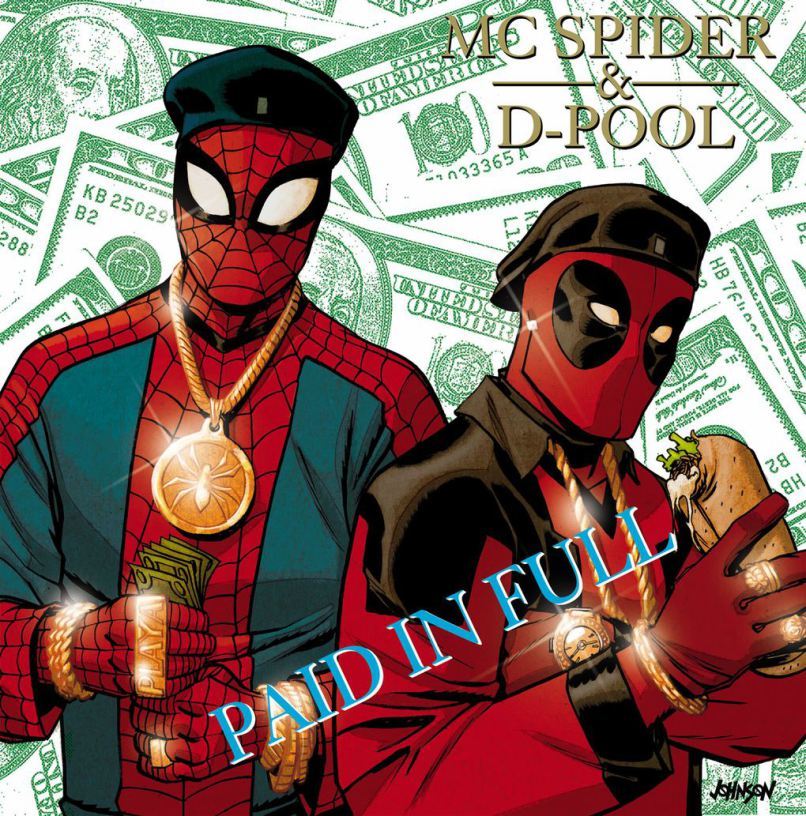
“In the case of the Hip-Hop Covers, we’ll be the first to say we underestimated how popular they’d become and the demand for those covers,” he said. “Regardless of whether the ‘incentive’ or ‘hoop’ as some folks like to call it was too high, too low, or just right, whatever it was, retailers had to take a lot of time to figure it out…and that was valuable time. Then you multiply that time drain by 30 titles in one month, 30 more after that and you get to see how long this process took them.”
“So regardless of whether they met the incentive initially or had to do the math to make it work (and possibly doing the math incorrectly, as well), retailers were bleary eyed by the time they finished placing their orders. This was the story I heard from every single retailer I spoke to,” he added.
The good news is they’re working with Diamond Comics Distributors on a solution to ease the process, which should roll out soon.
“I had been working with Diamond for a while to get a system in place where the retailer will have that number generated for them by a program and instantly appear when they go to order,” he said. “This takes the work out of the ‘hoop’ and then the retailer can decide if they want to purchase or not. I’m thrilled to say that I’ve already heard Diamond is testing the new program and should have it ready shortly, and this won’t just be for Marvel books, it’ll be for all publishers.”
The Final Word on Variants
In their most basic form, variants aren’t a bad thing. They’re like social media or smart phones or many other modern contrivances often blamed for the ills of the world. As a whole, it’s easy to see the inherent appeal and value of variants. They can be cool. These covers can show off a favorite artist in a new way or reveal another artist’s take on a comic you enjoy. They can stimulate the market and introduce readers to new titles and creators. In short, variant covers can be a powerful tool that brings real, tangible results.
As with anything, though, it all depends on how you use them.
Where variant covers go wrong is when the process is so convoluted comic shops have to study historical data like scripture just to figure out if they are ordering enough to get what they want (and even then they might screw up). Or when the average reader is desensitized by them or don’t even know when they’re buying one. Or when they’ve become so commonplace they aren’t special anymore. When they’re just another trope that confuses readers, frustrates retailers and doesn’t develop the industry in a sustainable way, that’s when variant covers become a net negative.
And we’re there. While I think there’s a place for them, their ubiquitous nature is a detriment to their own value. The industry could stand to dial back the usage and rethink how they roll these products out to their customers. The good news is, from the sound of it, that’s happening. Marvel sharing they’re both considering how they employ them and working on a new method to simplify the ordering of percentage based incentive variants is big. Others, like Image, have already made adjustments to how they handle these items, while Oni and Dark Horse are approaching the subject with all players considered. Sure, the same can’t be said for every publisher, but we’re seeing positive movement at the top.
And let’s be honest: it’s a complicated issue. These publishers are businesses and their goal is to make money. Variant covers help do that, at least for a time. And for some retailers, these items have and likely will continue to be a boon. Some readers lust over them, turning them into collectors items they will forever treasure. It’s not an open and shut case of “variants are bad and should be stopped.” Again, it’s a matter of perspective, and for some, the growth of variants has been welcome.
But the trend of variant usage needs to be reversed. While retailers are complicit in that – as Tomlin suggested, shops need to pass on them if they want to protect themselves – this is a top down issue. There are too many variants today and the ordering process could and should be simplified. I shouldn’t get a headache reading an email explaining how to order one title’s variant covers. I really shouldn’t. But that’s where we are. While I would never suggest they should be wiped out, all players involved should take a long, hard look at how variants are positioned today. It’s a subject that could determine not just the short-term viability of the direct market, but its long-term prospects as well.
Header image from Joe Quesada’s variant for Star Wars #1. Thanks to Dennis Barger, Bruno Batista, Peter Bickford, Patrick Brower, David Gabriel, Robert Harris, John Jackson Miller, Hank Kwon, Ben Lichtenstein, Sean Murphy, Megan Nielsen, Matt Parkinson, Eric Stephenson, Chris Thompson, Scott Tomlin and a laundry list of readers for sharing their perspectives for this piece. Come back tomorrow for the publisher comments in their full form.
April 2016 numbers manually counted and calculated by myself using Previews as a guide.
